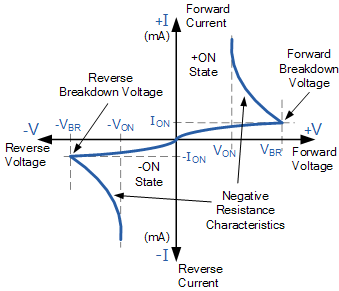The Diac
What is a Diac?
It is an electronic component that is very similar to a diode, but there are two differences:
- A DIAC can conduct current in both directions.
- The DIAC needs a voltage greater than the diode voltage (0.7) to move to the ON state
How does it work?
When applying a voltage to the Diac, it will not allow current to flow through it until the voltage reaches a certain threshold called Vbr (breakdown voltage).

How does diac work?
When the Diac is forward-biased (opened), it allows current to flow through it, and the voltage across its terminals decreases from Vbr to Von (on-state voltage).
Diac Symbol
The DIAC symbol used to depict this electronic component in circuit diagrams can be remembered as a combination of what may appear to be two diodes in parallel with each other but connected in opposite directions.
DIAC circuit symbol
The Diac has no anode, or cathode but A1, A2 (Anode 1, Anode 2), or MT1, MT2.